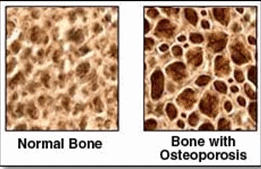Exercise and Osteoporosis: There's no bones about it!!!
By Heather Harmon, MPT, Optimal Performance Physical Therapy, LLCScarborough, Maine
 What is Osteoporosis?
What is Osteoporosis?
Osteoporosis is a disease of the bones. It is characterized by bones losing their density, and becoming more porous. It's basically like taking a pretty solid structure and poking a bunch of big holes in it (see the picture below)! You can imagine that this effectively weakens the bones, and puts those with the disease at higher risk for bone fractures or breaks.
Weakening of the bones can happen anywhere in the body, but there are certain locations that are more commonly affected - including the spine, hips, and forearms. BUT, here's the catch... many people do not know that they have osteoporosis! The disease process (weakening of the bones) in and of itself is not painful! That is why bone mineral density (BMD) testing is highly recommended for people at risk for developing the disease. BMD testing is non-painful, and is often covered by insurance - so be sure to discuss it with your healthcare provider! The results of this test will let you know strength of your bones, and determine if treatment is recommended.
Why should I care?
According to the National Osteoporosis Foundation, osteoporosis is a threat to 55% of Americans 50 years of age and older! Although women are about 4 times more likely than men to have the disease, it affects both sexes. They also estimate that 1 in 2 women and 1 in 4 men over the age of 50 will have an osteoporosis-related fracture during their remaining lifetime. Ouch! Sobering research has also found that, for older people, weak bones can be deadly. For example, if you are elderly, a broken hip makes you up to 4 times more likely than your peers to die within three months. Also, 1 in 5 people with a hip fracture ends up in a nursing home within a year. Fractures can increase fears of falling, lead to social isolation, depression, more sedentary lifestyles, and often a downward spiral of health.
What can I do about it?
There are a variety of treatment methods for osteoporosis - you and your doctor can determine what will be the best approach for you! Treatments include: medication, calcium and vitamin D supplements, lifestyle changes, and exercise. Often, a combination of many or all of these methods is most successful in effectively treating the disease.
Exercise and Osteoporosis
Because I am a physical therapist, my role in treating people with osteoporosis includes developing individualized exercise programs. Exercise is beneficial for people with osteoporosis, because it can significantly decrease your risk of fracturing your bones!
Here's how...
- Bones are living tissue - and, like muscle, the more you "work" or put stress on your bones (be warned - it must be the right kind of stress!), the stronger they will become. Two main types of exercise are important for building and maintaining bone density - they are weight-bearing and resistance exercises. Weight-bearing exercises are those in which you are bearing weight through your skeletal system (for example, brisk walking and aerobics). Resistance exercises are those in which your move against a challenging counter-force (for example, lifting weights).
- Working on exercises to improve your balance can decrease your chances of falling and suffering a painful bone fracture.
- Exercises can improve and make you more aware of your posture, which can help decrease the stresses on weakened bones. Professional advice along with certain exercises can also help you develop strategies to perform your activities of daily living - from household chores to recreational activities- without increasing the stresses on your bones.
Exercise/activity is essential in the effective treatment of osteoporosis; however, if you have already been diagnosed with the disease, have had an osteoporosis-related fracture or are noticing significant postural changes, it is often best and safest to seek professional advice on the types of activities and exercises that would most benefit you without increasing your risk of injury. Physicians that specialize in treatment of osteoporosis, physical therapists, and qualified trainers can help you develop a program that is appropriate for your needs and personal goals. So take a step in the right direction, and talk to your healthcare provider about osteoporosis prevention, diagnosis and treatment today!
Heather Harmon is a physical therapist at Optimal Performance Physical Therapy in Scarborough, Maine. Optimal Performance is a privately-owned practice dedicated to providing quality healthcare services to individuals of all ages and abilities. For more information about the practitioners, services, and treatments, please visit http://oppt.com/.
Herb's Tips and More
-
 Did you know that you can make soap, candles and lotion with your herbs?
Did you know that you can make soap, candles and lotion with your herbs? -
 Never take any herb identity for granted. The best way to be sure that you are using the right kind of herb is by buying it.
Never take any herb identity for granted. The best way to be sure that you are using the right kind of herb is by buying it. -
 Excellent health articles whether you are looking for information or inspiration regarding preventive health or are dealing with a medical
challenge.
Excellent health articles whether you are looking for information or inspiration regarding preventive health or are dealing with a medical
challenge.









